The Holy Mother’s Temple

This beautiful temple has been built exactly on the spot where the Holy Mother was born and it was here that her father Ramchandra Mukhopadhyaya had his original dwelling-house. The Holy Mother’s marriage also took place in this very house and her parents lived there till she reached the ninth year of her age.
This temple was dedicated to the Holy Mother by Swami Saradananda on thursday, the 19th April 1923 (i.e. on third day of the lunar half of the month of Vaisakh called Akshaya-Tritiya). The white marble statue of the Holy Mother was installed in the temple on 8th April 1954, and a spacious Prayer Hall was also added as an annexe to this temple. The sacred relies of the Holy Mother have been preserved in the Sanctum (Garbha-mandira) and the Holy Mother is daily worshipped with appropriate rites and offerings. The small-sized Shiva-Linga (the stone emblem of God Shiva) which was found at the time of digging the earth for the construction of this temple is also worshiped here.
The metallic flag embossed with the sacred word ‘Ma’ (Mother) adorns the crest of the dome of the temple and is calling, as it were, all travellers to come here to receive the infinite love and grace of the Holy Mother. Innumerable devotees are visiting this sacred place from far and near.
Joyrambati
This village is located within the jurisdiction of Kotulpur Police Station in Vishnupur Subdivision of Bankura District. It stands about three miles to the west of Kamarpukur and two miles to the east of Sihar - the birthplace of Hridayram Mukhopadhyay, a nephew of Sri Ramakrishna. One has to cross the rivulet Amodar and vast open field to reach the village of Deshra which lies to the north of Joyrambati. Vishnupur and Arambagh are located at twenty-seven miles and about twelve miles and a half respectively from Joyrambati.
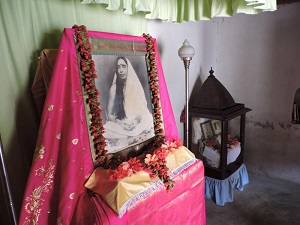
The natural scenery of Joyrambati is charming. This village, surrounded on all sides by green pastures, untrimmed meadows, trees and shrubs, breathes a typical rural atmosphere. The area that extends for about half a mile between this village and the Amodar is very fertile and yields all kinds of vegetables and other agricultural products. After the birth of Holy Mother, who is the veritable embodiment of Lakshmi, the Goddess of Fortune, the village began to show distinct signs of prosperity and profusion which were not so much in evidence before her advent.
The main source of irrigating the nearby cultivable lands is the big lake called ‘Mother’s Tank’ where the visitors and the village-folk take bath. It is said that the Holy Mother in her girlhood used to cut aquatic grass for cows in neck-deep water from this very tank. At present water is supplied to this reservoir from the river Amodar by means of an electric pump and is utilized for irrigation of the surrounding fields for the purpose of cultivation. There is, besides, another tank called ‘Barujjey pukur’ (i.e. Banerjee’s tank) which lies on the south-eastern corner of this village and is surrounded with palmyra trees. Since the birth of the Holy Mother, this picturesque village with its sacred traditions has become one of the most holy places of pilgrimage in the world. On one occasion, Holy Mother, after touching the dust of this place with her forehead, remarked, ‘One’s own mother and the land of birth are even superior to heaven’ .
Puratan-Bari (Old House) of Holy Mother
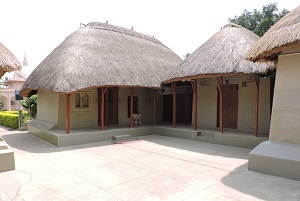
At the time of the division of properties among the brothers of the Holy Mother, the house where she had so long been living, fell to the share of her brother Prasanna Mukhopadhyay and she lived in that homestead along with him as before for a long time. This dwelling-place is called at present ‘Mother’s Old House’ (Puratan Bari).
The authorities of Belur Math purchased the aforesaid house from the descendants of Prasanna and placed it under the care and supervision of the Ashrama for the preservation of the sacred memories of Holy Mother. She used this house for about fifty-two years (i.e. from1863 to 1915). Many persons received initiation, Brahmacharya and Sannyasa from her in this house and thus it became blessed. Besides, she held the worship of the Goddess Jagaddhatri in this very residence.
Nutan-Bari (New House) of Holy Mother
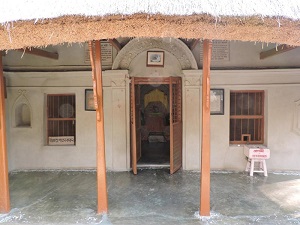
With the increase in the number of devotees, various kinds of difficulties cropped up regarding accommodation in the original house. That was why Swami Saradananda bought a piece of land on the western side of the tank called ‘Punya Pukur’, and got a separate house build thereon for Holy Mother in 1915-16. It was registered in the name of Goddess Jagaddhatri. This new house consists of four mud walled and straw roofed rooms in its four corners. She utilized one of these rooms as her bed-chamber and also for her worship of Sri Ramakrishna. She gave initiation, Brahmacharya and Sannyasa to aspirants in this room also. At present, this room has been converted into temple with a life-sized portrait of the Holy Mother installed therein. The room adjoining it was used as a kitchen whereas the room opposite to the kitchen was occupied by Nalini Didi, niece of the Holy Mother. The remaining room, which faces the west and is now encircled by railings, was reserved for the Holy Mother’s worship of the Goddess Jagaddhatri, and, at other times, for the accommodation of devotees. The monastic disciples of Sri Ramakrishna such as Swami Saradananda and Swami Subodhananda and also other devotees lived in that room on the occasion of their visit to Joyrambati.
Punya-Pukur
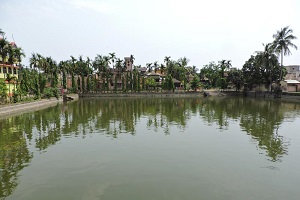
This tank lies on the eastern side of the Holy Mother’s New House and in front of the temple. It is called Punya–Pukur (the Holy Tank) because of its constant use by the Holy Mother.
Mayer Dighi (Ghat)
The bus-stop at the Mother's Temple in Jayrambati is known as Mayer-Ghat. It lies on the banks of a tank called Mayer Dighi. During her younger days, Mother used to cut grass from the banks of this tank to feed the cows. classes of people.
Amodar Ghat (Bathing-Ghat of Holy Mother)
.jpg)
The Rivulet Amodar, which was regarded by the Holy Mother as the Ganga, has formed on the northern out-skirt of the village a sort of a triangular-shaped peninsula which looks exactly like the back of a tortoise. Being dotted with marks of cremation, it presents a picturesque sight that excites a spirit of renunciation by reminding people of the transitoriness of the world. The course of the Amodar is towards the north at this particular place. Swami Saradananda used to meditate daily under the shade of the Amlak (myrobalan) tree that stood in the middle of this small peninsula during his stay at Joyrambati. Yogin-Ma, Golap–Ma and others, after their bath in this sacred river spent much of their time in meditation and in reading of the Gita, Chandi etc. Subsequently, a brick-built bathing-ghat was constructed on the spot where the Holy Mother used to take bath.
The Temple of Simhavahini
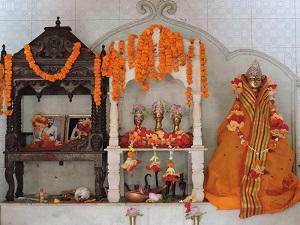
The Goddess Simhavahini is represented in the form of a metallic pitcher. The Holy Mother said that, once while she was lying before the temple under a vow of fasting to get her blessings for the cure of an acute disease from which she had been suffering for a long time, the Goddess Simhavahini appeared before her and her mother Shyamasundari in the guise of a blacksmith girl of about eleven or twelve years of age and suggested remedial medicines to them, which cured her completely. The Holy Mother after her recovery preserved some quantity of earth of this sacred place in a small casket, partook of it everyday and also gave it to Radhu (Radharani), one of her nieces. After the discovery of the curative power of this earth, persons from distant places began to swarm into this place to collect this holy earth with great devotion for the various kinds of maladies, and also as an effective medicine for snake-bite. That was why this Goddess attained to wide celebrity and great popularity among all classes of people.
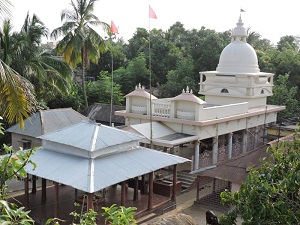
The old temple having been damaged beyond repair with the passage of time, the Goddess has of late been reinstalled in the newly built permanent temple where she is now daily worshipped. The front portion is covered with shed for the devotees. The Goddess Simhavahini and her two companions Sri Chandi and Mahamaya represented in metallic pitchers, have been installed therein on a raised platform and the Goddess Manasa has also been placed by their on the separate pedestal. A good number of devotees are coming to visit and worship the Goddess especially on Saturdays and Tuesdays from far and near. During the Durga Puja ceremony, the Goddess Simhavahini is worshipped with due éclat and solemnly for three days with various offerings. The descendants of the Holy Mother’s ancestral Mukherjee-family have all along been carrying on the worship of the Goddess.
Dharma-Thakur's Temple
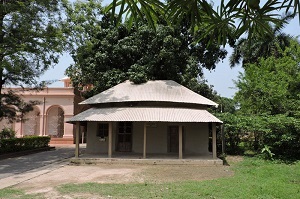
Dhamra-Thakur, who is the presiding Deity of the village, enshrined in a small mud- walled thatched house consisting of two rooms. He is worshipped under two different names at two separate places. His temple is located on the north-western corner of the Punya-Pukur. In one of the rooms, there is the tortoise-shaped Dhama-Thakur named Sundaranarayana who is still worshipped by members of the Mukherjee-family by turns, along with Sitala Devi and the stone-emblem of Narayana installed therein. The Goddess Kali was worshipped in the adjoining room, but it has been discontinued for good. There is another brick-built temple of Dharma-Thakur named ‘Yatra-SiddhiRay’ who is the family Deity of the Ghosh family. It stands at the western end of the village in front of the Mother’s Ghat.
Barujjey-Pukur / Tal-Pukur
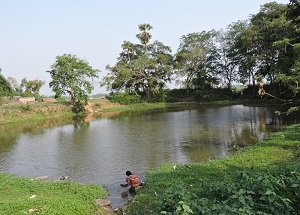
This tank is also called ‘Tal-Pukur’ as it is surrounded on all sides by a row of Palmyra trees. It lies on the south eastern corner of the village. This tank is a ten-minute walk from Mother's House in the southern part of the village. The Holy Mother used to take her bath daily in this deep tank and also used its water for drinking and cooking purpose. When her children took leave of her after a few days of stay with her, she accompanied them up to this tank and stood staring at them till they disappeared from her sight.
The Site of Bhanu-Pishi's House
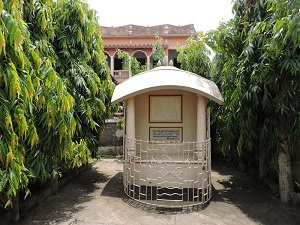
The ancestral home of Bhanu-pishi who was fortunate enough to receive the blessings of Sri Ramakrishna and was a companion of the Holy Mother in her younger days, stands near the Holy Mother’s temple. She was regarded by Holy Mother as her aunt in terms of relationship existing between neighbors in a village. She was married in Phului Shyambazar which is not very far from Joyrambati. After the death of her husband, she came back to her ancestral home at Joyrambati. She entertained a great respect for the Holy Mother whom she looked upon as the Goddess Herself. The Holy Mother in her younger days often repaired to this house of Bhanu-Pishi to get mental peace and solace when the villagers wounded her susceptibilities by describing Sri Ramakrishna as her lunatic husband. The site of that house is seen at a little distance from the Mother’s New House (Nutan Bari).
Presently the site of Bhanu Pishi’s house has been taken over by Sri Sri Matri Mandir and renovated.